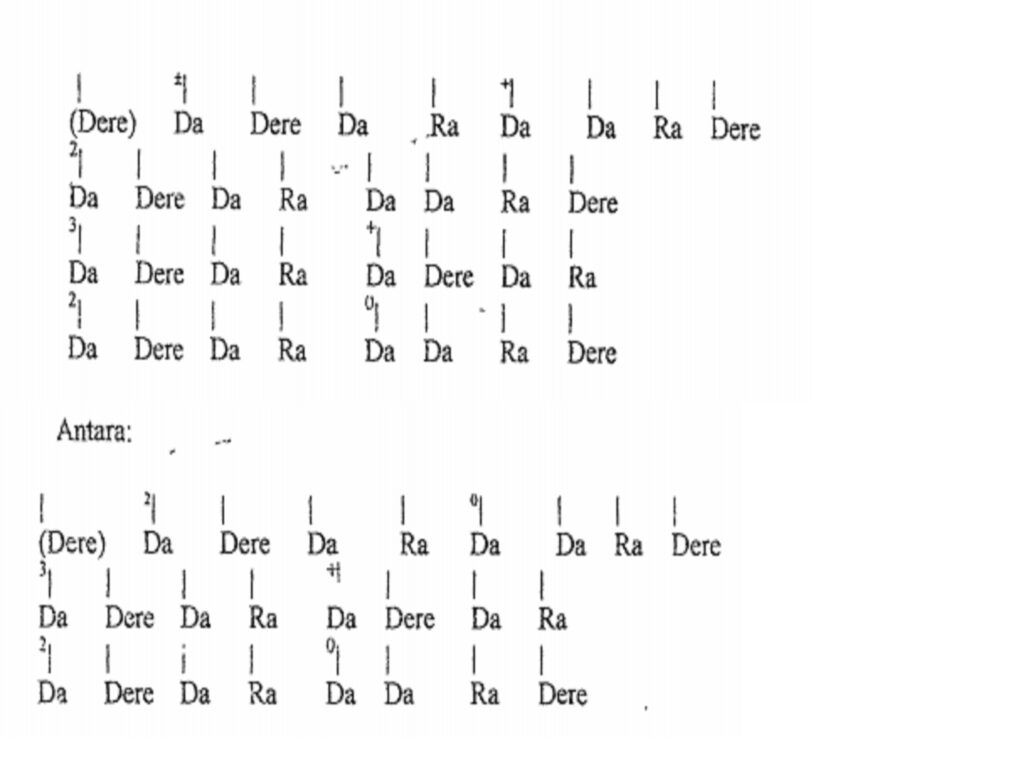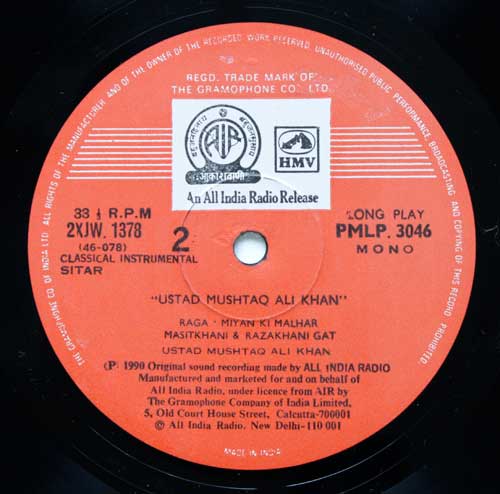Bhabanishankar Dasgupta
The VILAMBIT (slow) GAT compositions set to TEENTAL (16 beat rhythm) which are played on stringed instruments such as SARODE, SITAR, ESRAJ or SARENGI are referred to as MASIDKHANI GATS.MASID KHAN, a venerable maestro was the creator of this particular genre. Formerly the style introduced by AMIR KHUSRU was followed by most instrumentalists. KARIMSEN, the great grandson of TANSEN was a proficient BEEN and RABAB player. His grandson MASID KHAN brought about a revolutionary change in the previous conventions of instrumental music and successfully trained his son BAHADUR KHAN in his individual style. BAHADUR KHAN or BAHADUR SEN assiduously followed the style introduced by his father and subsequently his descendants created the JAIPUR BAAJ or musical technique on the basis of this style.

The MASIDKHANI style was created according to the conventions of VILAMBIT (slow) KHEYAL and the main techniques of instrumental music, such as JOD, TODA and VISTAR were included in this style. AMRIT SEN the illustrious sitar player of JAIPUR was the great grandson of BAHADUR SEN. His nephew AMIR KHAN was a court musi8cian at MYSORE.BAHADUR SEN had an able disciple named QUTUB BAKSH who subsequently came to be known as QUTUBUDAULLAH. His exquisite compositions are played by musicians even today. BARKATULLAH KHAN, the eminent sitar player of MYSORE PALACE was a disciple of AMIR KHAN. His recital in raga BHUP KALYAN contained in a disc record (which is no longer available) clearly reflected the style introduced by USTAD MASID KHAN.

USTAD MASID KHAN attached five strings instead of three strings to his SITAR. But there were no CHIKARI or TARAB (sympathetic) strings on his instrument, because the sitar players of JAIPUR GHARANA did not use sympathetic strings even thirty years ago. MASID KHANI baaj (style) is commonly referred to as PASCHIMI BAAJ (western style),In fact USTAD MASID KHAN was the first maestro to compose and play VILAMBIT(slow)GATS on the SITA Recording to the conventions of vocal music(KHEYAL).Different musical patterns such as TAN,TODA, VISTAR etc. were often executed according to the style and technique of vocal music(KHEYAL)while playing VILAMBIT GAT compositions. These GAT compositions are played by musicians even today and are generally set to VILAMBIT (slow) TEENTAL. Nowadays the word MASIDKHANI GAT has become synonymous with VILAMBIT (slow) TEENTAL GATS. The structure of a MASID KHANI GAT goes like this:–
DE RE/DA DERE DA RA/DA DA RA DERE/DA DERE DA RA/DA DA RA DERE A MASIDKHANI or VILAMBIT TEENTAL composition consists of four quatrains. A quatrain is generally referred to as a WARDHA in HINDI or URDU language. The first, the second, the third and the fourth quatrains are known as STHAYEE, ANTARA, SANCHARI and ABHOG respectively. Between STHAYEE and ANTARA there is another quatrain known as MANJHA. This is an integral part of the STHAYEE and is so referred to because it comes amidst the STHAYEE and the ANTARA. In HINDI, the word MANJHA signifies something that is located in the middle.
After playing the STHAYEE, MANJHA and ANTARA the character of a particular raga is portrayed with special emphasis on the principal notes of the RAGA. The principal notes are referred to as VADI, SAMVADI, ANUVADI and VIVADI in order of importance. While playing a MASIDKHANI GAT,a musician generally begins a TAN from the SOM (FIRST BEAT) ends it at the 10th MATRA (BEAT)and returns to the GAT composition at the 11th MATRA (BEAT).It is worthwhile to mention in this context that in TEENTAL(16 beat rhythm)the 9th,10th,11th and 12th MATRAS (beats)are jointly referred to as KHALI(off beat section) Nowadays MASID KHANI GATS are often played on the SARODE, SITAR,CLASSICAL GUIITAR and the SANTOOR and occasionally on the SARENGI, the ESRAJ and the VIOLIN to the accompaniment of the TABLA.
References
- https://www.google.com/search?q=masitkhani+gat&rlz=1C1SQJL_enIN883IN883&sxsrf=ACYBGNRvh9_nuWQOJu0Pm7UaKDxsBFj6wA:1580227604780&source=lnms&tbm=isch&sa=X&ved=2ahUKEwiw_q_I1qbnAhWQT30KHRTnAq0Q_AUoAnoECA0QBA&biw=1366&bih=576#imgrc=4mREh0C6RUKiGM:
- https://saraswatisangeetsadhana.in/gat-in-indian-classical-music-in-hindi-गत-की-परिभाषा/
- https://www.youtube.com/watch?v=ngWMMKTHFWI&t=1134s

